Headless Content Management Systems (CMS) are redefining how content is managed and delivered online, significantly impacting Search Engine Optimization (SEO). This headless CMS SEO guide begins with exploring the concept of headless CMS, which separates content management from site presentation, offering enhanced flexibility and efficiency. We discuss how headless CMS improves SEO, compare it with traditional CMS, and review the best headless CMS platforms and SEO tools suitable for such systems. More than that, we also provide practical SEO tips for headless CMS, accompanied by successful case studies, to illustrate the profound impact on digital marketing strategies.
Table of Contents
Understanding Headless CMS SEO
The Explanation of Headless CMS
The concept of a headless CMS is best grasped by reflecting on the limitations of traditional content management systems. Legacy platforms such as WordPress, Drupal, and Sitecore emerged when the web was young, catering mainly to website content (text, images, and videos).
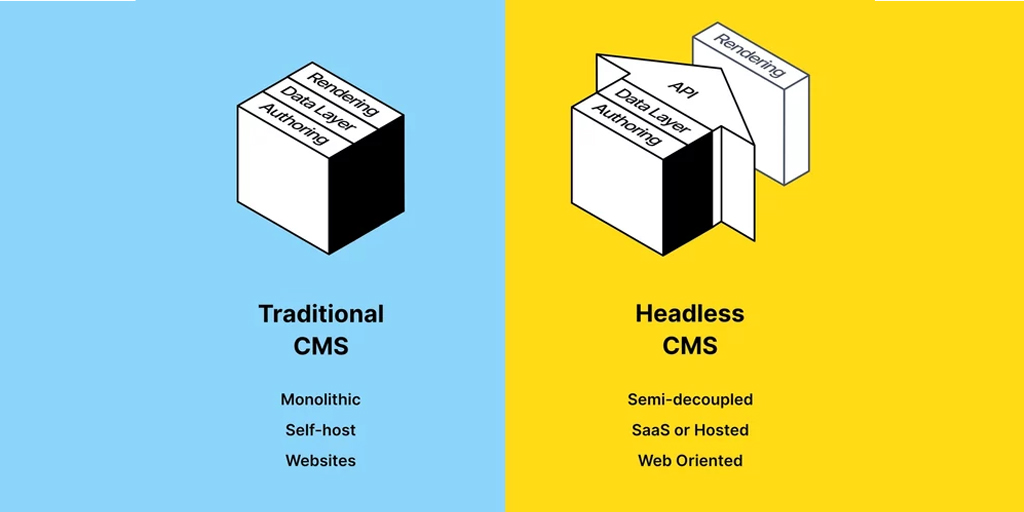
In a conventional setup, all website components (content, images, HTML, and CSS) are bundled together, which can restrict content reuse because it’s intricately linked with specific code and format. But as the digital landscape expanded, the one-size-fits-all mold of traditional CMSs proved inadequate. Enterprises began to explore beyond web pages, stepping into a world of mobile apps, interactive displays, voice assistants, and other digital touchpoints.
The rigid, page-centric structure of a traditional CMS can’t accommodate the fluidity required by these new mediums. A headless CMS strips away these constraints, liberating content from the confines of a singular platform, and enabling it to flow seamlessly into the diverse digital channels of today’s world.
So, what is headless CMS?
A headless CMS represents a modern approach to content management. Unlike traditional CMSs that intertwine content creation with its final presentation, a headless CMS strictly focuses on the backend management of content, essentially decoupling content from its display. This separation means content stored and managed in a headless CMS can be published across an array of platforms and devices, anything from websites to mobile apps, smart devices, and beyond.
It empowers marketers to oversee content without interference, while developers can leverage the freedom to craft bespoke front-end experiences, optimize for performance, and handle a digital ecosystem at a grand scale. Traditional CMSs tend to mesh content with the design, making content recycling tough and limiting the creation of dynamic digital experiences.
How Headless CMS Enhances SEO
A headless CMS can significantly enhance SEO efforts through several key features:
Headless CMS increases Content Flexibility and Reusability
With a headless CMS, content is stored as data that can be called upon and presented in any format across various platforms. This flexibility allows for content to be reused in different contexts without the need for duplication. Search engines value unique, relevant content that is consistent across platforms, and a headless CMS makes managing this type of content strategy simpler. It also enables teams to update content in one place, ensuring that all instances across platforms are current and SEO-optimized.
Headless CMS Improves Site Speed and Performance
Site speed is a well-known ranking factor for search engines. A headless CMS can contribute to faster websites since the backend is separate from the front end, meaning there’s less processing required when pages are loaded. Developers can also use the latest front-end technologies that are optimized for speed, without being constrained by the backend system. Faster load times improve user experience and can contribute to higher rankings on search engine results pages (SERPs).
Headless CMS Is Great for Mobile Optimization
Mobile optimization is another critical factor in SEO, as search engines like Google use mobile-first indexing. A headless CMS makes it easier to deliver content to mobile users in an optimized format. Because it allows for content to be served via APIs to any device, it ensures that the mobile user experience is as strong as the desktop one. This adaptability to various screen sizes and platforms can positively impact a site’s search engine ranking.
Better SEO-Friendly URL Structures with Headless CMS
Creating clean, descriptive URLs is crucial for SEO. While traditional CMS platforms might limit URL structures based on their built-in templating systems, a headless CMS often allows for greater customization. Developers can craft URL structures that are intuitive and keyword-rich, which can improve search visibility and click-through rates. Additionally, the freedom to structure URLs without constraints can lead to better information architecture, helping search engines understand and index content more effectively.
How Headless CMS SEO Differs from Traditional CMS SEO
The way a headless CMS impacts SEO differs markedly from that of a traditional CMS, offering several benefits for organizations that prioritize their online presence.
- Ability to Scale Content Production: A headless CMS is transformative in how it enables content scalability. Without the typical front-end design restrictions of a traditional CMS, SEO professionals can focus purely on content optimization. The synergy between content creators and SEO personnel is enhanced, streamlining workflows and allowing for quick scaling of content across different platforms and channels.
- Improve Collaboration Between Teams: The separation inherent in a headless CMS facilitates a harmonious work environment. SEO experts can fine-tune content for search engines without interrupting the developers’ workflow. The platform’s in-built SEO tools, such as features for structured data and customizable URLs, help integrate SEO strategies effortlessly. This efficient division of labor leads to better search rankings, superior user experiences, and ultimately, a stronger digital footprint.
- Improved Web Security: A key advantage of a headless CMS is its contribution to enhanced web security. The system’s API-driven approach means developers can use any tech stack to build the front end, keeping the backend securely away from the web layer. This separation minimizes vulnerabilities, shielding sensitive data and infrastructure from web-based attacks, a security risk often associated with traditional CMS themes and templates.
- Faster Load Speeds: Developers can create more efficient web applications free from the constraints of a coupled CMS backend. A headless CMS leverages APIs to deliver content straight to the user interface, simplifying the delivery process and reducing the load that typically comes with traditional CMS setups. The result is a lightweight application architecture that can lead to faster website loading times, benefiting both user experience and SEO.
Choosing the Right Tools to Create the Best Headless CMS SEO
To help you choose the best headless CMS for your website’s SEO, we have conducted a list of CMS that are worth mentioning. Please keep in mind that our list is not ranking-based, so it won’t tell you if a headless CMS is better than another. It’s up to you to consider and decide which one is suitable for your business.
Storyblok: A Top-Rated Headless CMS for SEO
Reviews on G2: 4.4/5 (387 reviews)
Price for Entry-level: Free
Storyblok is an excellent CMS for SEO due to its headless approach, comprehensive SEO plugin, and rich SEO features. Its flexibility allows users to deliver content across multiple platforms smoothly and provides a wide range of SEO tools and customization options to optimize your website effectively.
Storyblok is recognized for its ease of use, coming in 3rd for the easiest-to-use software in its category, rated by G2. It’s a versatile service catering to various needs ranging from corporate websites and eCommerce to mobile applications and display screens.
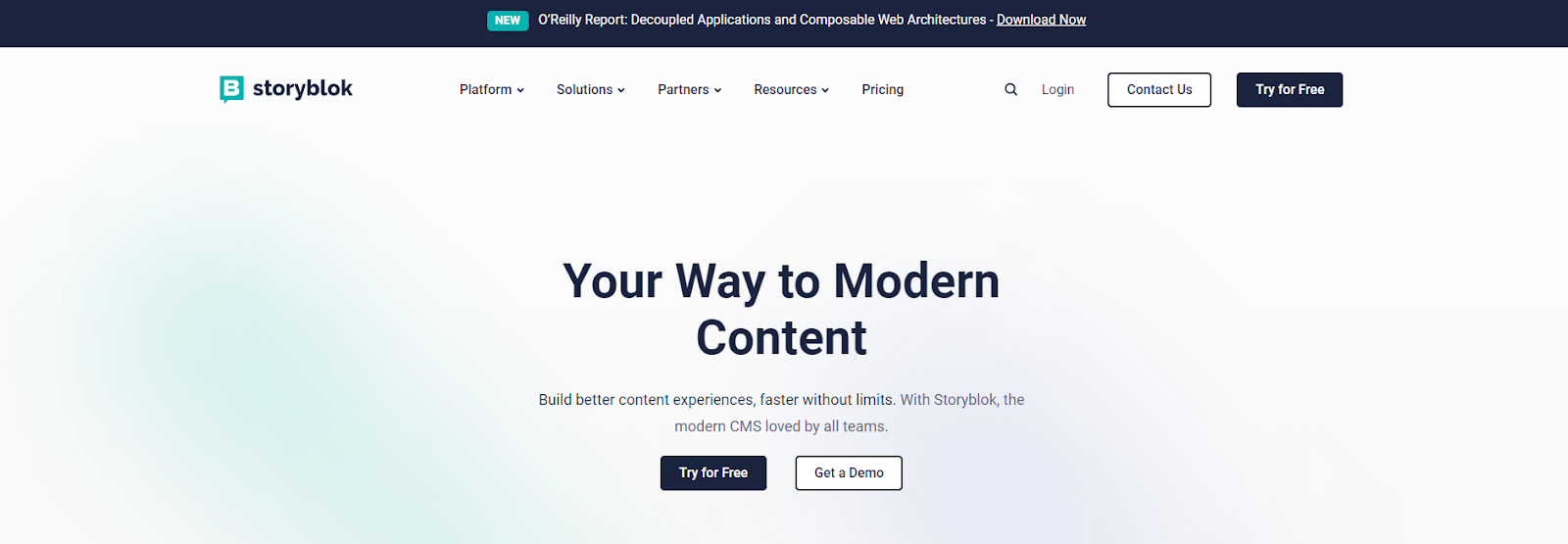
Some of Storyblok’s best features:
- Easily Integrated: At its core, Storyblok is designed to empower teams to craft and manage their narratives across multiple use cases. As a headless CMS with a visual editor, it simplifies the task of content creation and management while allowing for seamless integration into any desired output channel, be it a website, app, or any digital display.
- Dev-friendly and perfect for tech-related Industries: The platform is highly favored by software engineers and frontend developers for its developer-friendly setup. Storyblok has gained traction predominantly in the information technology and services sector as well as the computer software industry, making it a go-to for professionals in these fields.
- SMEs-focused: It appeals broadly to the market, with 63% of its users being small businesses, showcasing its suitability for rising enterprises. Additionally, 29% of its clientele are mid-market businesses, indicating its ability to scale and accommodate growing content demands.
Sanity: A Premier Choice for Headless CMS
Reviews on G2: 4.7/5 (717 reviews)
Price for Entry-level: Free
Sanity shines as a headless CMS, renowned for its user-friendliness. It’s ranked as the easiest-to-use headless CMS, ranked by G2. This high usability score reflects its commitment to providing a seamless content management experience. Sanity positions itself as more than just a CMS; it’s a Composable Content Cloud that offers a highly customizable platform.
It views content as data, which can be used to fuel various aspects of a digital business. This flexible approach allows organizations to manipulate and present their content in innovative ways that suit their specific needs.
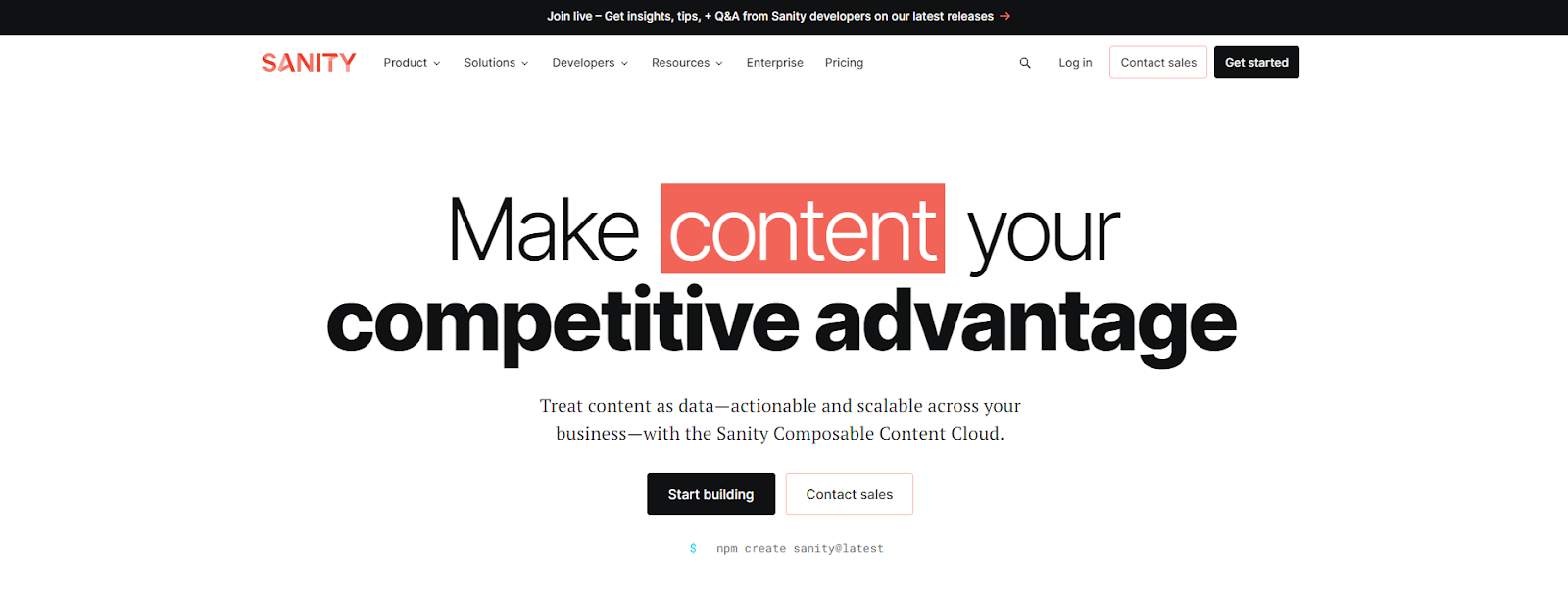
The platform is engineered for software engineers and web developers, indicating its advanced capabilities and developer-centric features. Sanity has made a significant impact on the computer software and information technology services industries, signaling its effectiveness in these high-tech fields.
Notably, Sanity is trusted by leading brands such as PUMA, Sonos, Skims, and Figma. This endorsement by high-profile companies serves as a testament to its reliability and the value it brings to businesses. It’s also clear that Sanity is particularly favored by small businesses, with 78% of its users representing this segment.
This dominance suggests that Sanity offers the scalability and flexibility that small businesses need to grow their digital presence. Meanwhile, 16% of its users are from the mid-market segment, proving that Sanity can also support larger organizations with more complex content management needs.
Hygraph: Empowering Versatility, Scaling Success
Reviews on G2: 4.6/5 (221 reviews)
Price for Entry-Level: Free plan available; professional plans start at $299 a month.
Hygraph, formerly known as GraphCMS, is a next-generation headless CMS and SEO that has been widely recognized for its comprehensive functionality and ease of use. Highly rated on G2 and ranked as the 4th easiest to use in headless CMS software, Hygraph offers a unique content federation approach, enabling seamless integration and distribution of content across various platforms.
Its powerful GraphQL API facilitates the true composability of tech stacks, allowing for efficient and flexible content management. This platform is particularly favored by software engineers and is widely used in industries like computer software and information technology services.

Hygraph excels in providing access to a wide range of Content Delivery Networks (CDN), ensuring rapid and efficient data service. It integrates smoothly with static site generators, SDKs, and other third-party applications, enhancing its versatility and scalability. This makes it a robust choice for small businesses (71% of its user base) and mid-market companies (22%).
Hygraph’s approach to content management, centered around its federated content management platform and GraphQL content APIs, empowers users to build engaging digital experiences with modern stacks. The platform’s focus on high-performance, efficient content workflows, and a rich editing experience positions it as a leading solution for businesses seeking to future-proof their content management strategies and enhance their global content distribution.
Butter CMS
Reviews on G2: 4.7/5 (179 reviews)
Price for Entry-Level: Free plan available; professional plans start at $83 a month.
Butter CMS has established itself as a leading headless CMS, particularly favored for its ease of use and strong SEO support. This platform stands out in the market with its user-friendly interface and functionality, as evidenced by its high rating of 4.7 out of 5 on G2. It is designed to cater to both marketers and developers, ensuring a seamless content management experience.

One of the main attractions of Butter CMS is its robust headless SEO support and its compatibility with various frameworks, which grants it a significant edge in terms of versatility. The integration with Content Delivery Networks (CDNs) enhances the speed and efficiency of content delivery, a critical factor for both SEO performance and user experience.
Moreover, the platform’s rapid content update feature ensures that the content remains dynamic and current. Butter CMS offers a secure and customizable admin page, which adds to its appeal. The platform is predominantly used by small businesses, accounting for 68% of its user base, and by mid-market companies, which make up 25%. This diverse user base highlights the platform’s scalability and its ability to cater to a wide range of business needs.
With a free entry-level plan and affordable professional options, Butter CMS is accessible to a broad spectrum of users. From individual creators to larger organizations, Butter CMS is an attractive option for those looking to enhance their content management strategies and improve their online presence.
Strapi
Reviews on G2: 4.5/5 (169 reviews)
Price for Entry-Level: A free plan is available; paid packages start at $29 a month.
Strapi is recognized as the leading open-source headless CMS and ranked as the 16th easiest to use in headless CMS software. It stands out for being 100% JavaScript, extensible, and fully customizable. Strapi’s appeal lies in its ability to provide developers with a customizable API right out of the box, offering the freedom to work with preferred tools and technologies.
The CMS is designed to cater to a diverse range of users, including software engineers and students, and is widely used in industries like non-profit organization management and computer software.
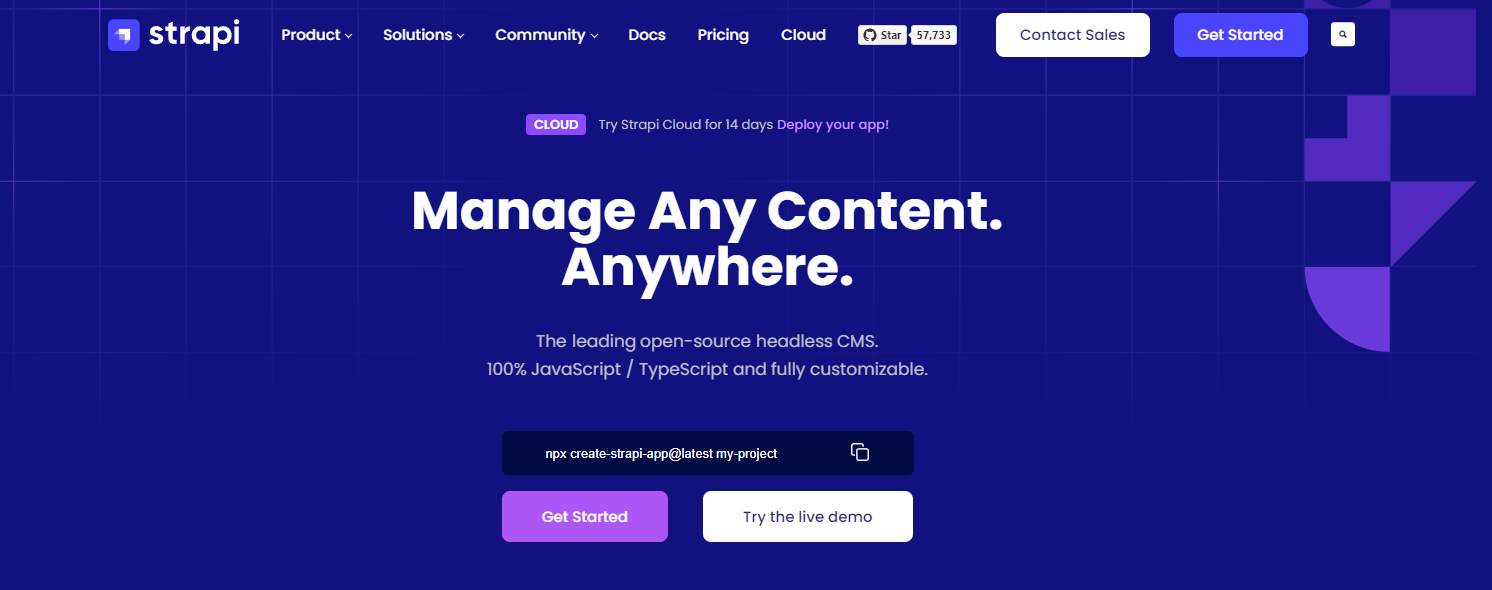
A major advantage of Strapi is its customization capabilities and easy-to-use API, making it a favorite among developers. It supports self-hosting as well as hosting on any server of choice or the cloud, providing users with flexibility and control over their content management infrastructure. Furthermore, Strapi facilitates the integration of third-party applications, enhancing its functionality and adaptability.
This CMS serves primarily small businesses (78% of its user base) and mid-market companies (16%), showcasing its scalability and suitability for various business sizes. Strapi’s commitment to open-source development, coupled with its extensive global community of over 150,000 enthusiasts and 700+ contributors, ensures continuous improvement and a wide range of support for its users. This makes Strapi an ideal solution for those looking for a versatile, developer-friendly headless CMS.
Contentful
Reviews on G2: 4.2/5 (295 reviews)
Price for Entry-Level: Free plan available; paid plans start at $489.
Contentful, one of the pioneering headless CMS platforms, has a strong presence in the CMS market with a G2 rating of 4.2 out of 5 and is noted as the 9th easiest to use in headless CMS software. Hosted on AWS, it integrates seamlessly with third-party applications like Cloudinary and Gatsby, supporting a wide range of languages and frameworks.
Its focus on an API-first approach caters to a diverse user base, including software engineers and content managers, and is particularly popular in the information technology and computer software industries.
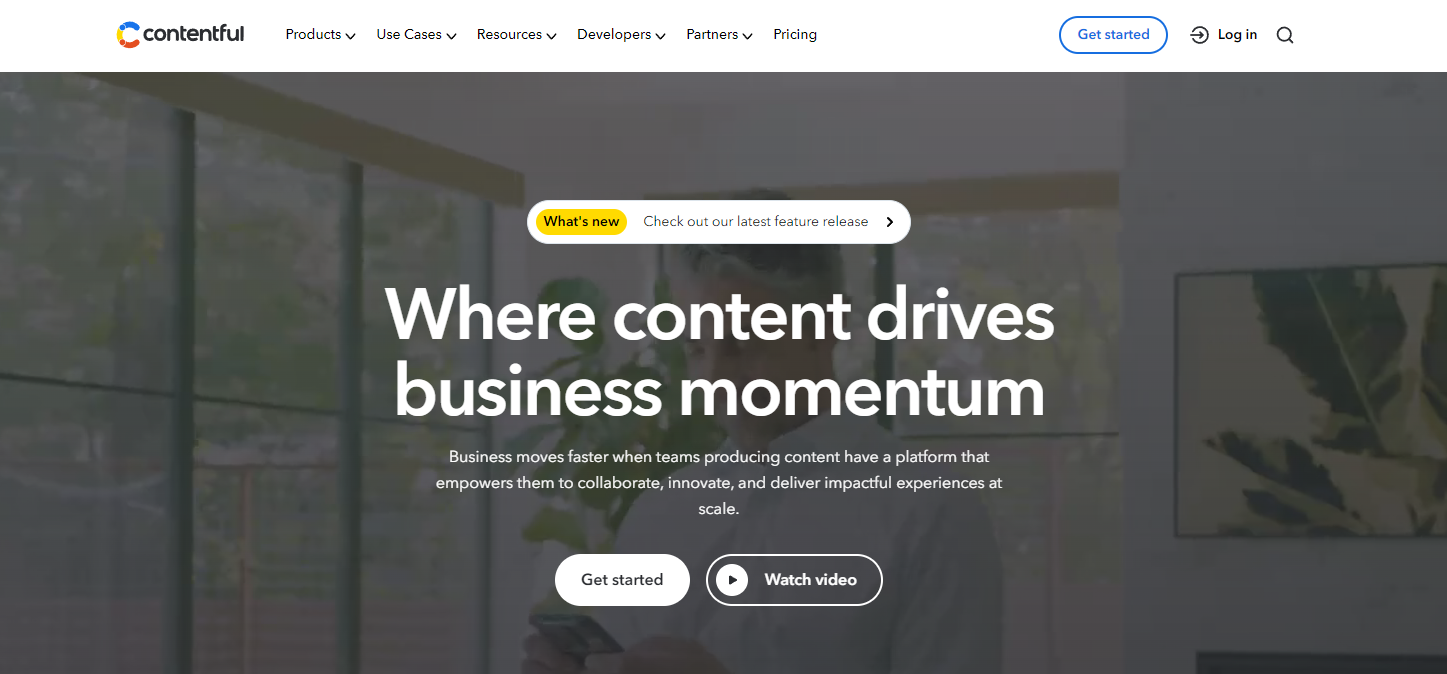
Contentful stands out for its fast content updates and customizable user interface, enhancing the efficiency and user experience for content management. It offers a comprehensive and unified composable content platform, enabling users to create content once and reuse it across various digital experiences.
The platform supports innovative content orchestration, a robust app ecosystem, and an app framework to easily extend its capabilities. With nearly 30% of Fortune 500 companies and thousands of organizations globally relying on Contentful, it demonstrates its ability to unlock digital content as a strategic business asset.
The platform empowers teams to collaborate and deliver impactful experiences at scale, featuring tools for AI-powered content automation and a flexible tech stack that meets specific business needs. Contentful’s composable content approach breaks down content into modular components, allowing for versatile and multi-channel content distribution, making it a strategic choice for organizations seeking a powerful and scalable content management solution.
Agility CMS
Reviews on G2: 4.4/5 (159 reviews)
Price for Entry-Level: Limited free plan available; paid plans start at $900 a month.
Agility CMS is recognized for its quick response and user-friendly interface. It is a headless CMS that provides a personalized and easily customized interface, catering to the needs of web developers and businesses in the information technology and computer software industries. The platform is known for its API-first approach and flexible architecture, making it a preferred choice for businesses seeking scalable and future-proofed content management solutions.
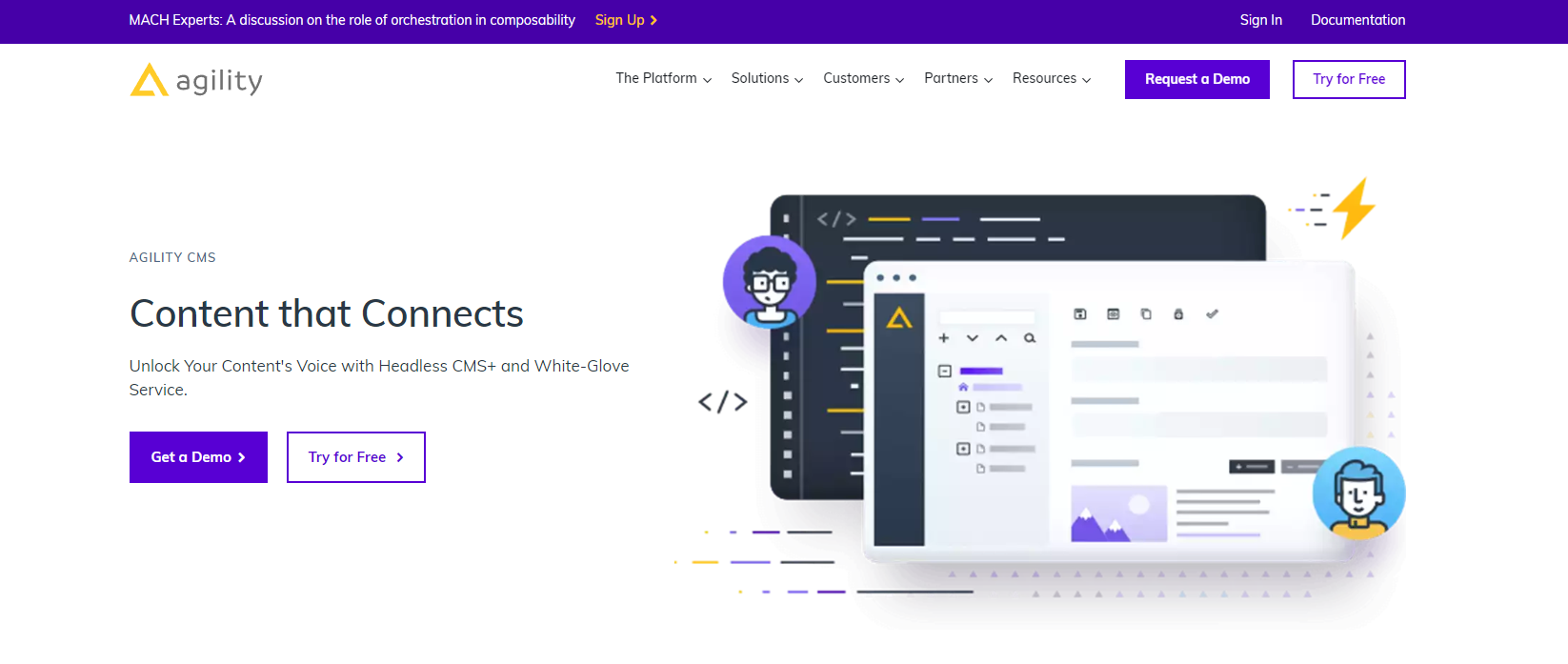
Agility CMS stands out for its fast content updates, efficient page and module management, and unique content-first approach. Its composable architecture enables seamless integration with any front-end and coding language, offering RESTful APIs, open-source SDKs, or Jamstack technologies for versatile content delivery.
The platform is designed to be adaptable, allowing businesses to easily tailor their digital experiences to specific requirements. Agility CMS also offers low-code content creation and management, enabling users to manage pages using reusable blogs and sitemaps without extensive developer involvement.
Additionally, built-in workflows and content scheduling streamline content production, and the ability to share content previews with external users enhances collaboration. The platform’s focus on flexibility in content structure and relationships allows for efficient content reordering, reuse, and repurposing across digital channels, making it an effective solution for businesses looking to enhance their digital presence and content management strategies.
Content stack
Reviews on G2: 4.6/5 (95 reviews)
Price for Entry-Level: Offers a free trial; paid plans start at $995 a month.
Contentstack is ranked as the 13th easiest to use in headless CMS software, and it is also renowned for its fully automated composable digital experience platform, powered by a leading headless CMS. It caters to industries such as computer software and financial services and is especially favored by enterprise (41%) and mid-market (33%) segments. Contentstack’s platform is designed to empower both marketers and developers, enabling them to deliver composable digital experiences at high speed and scale.
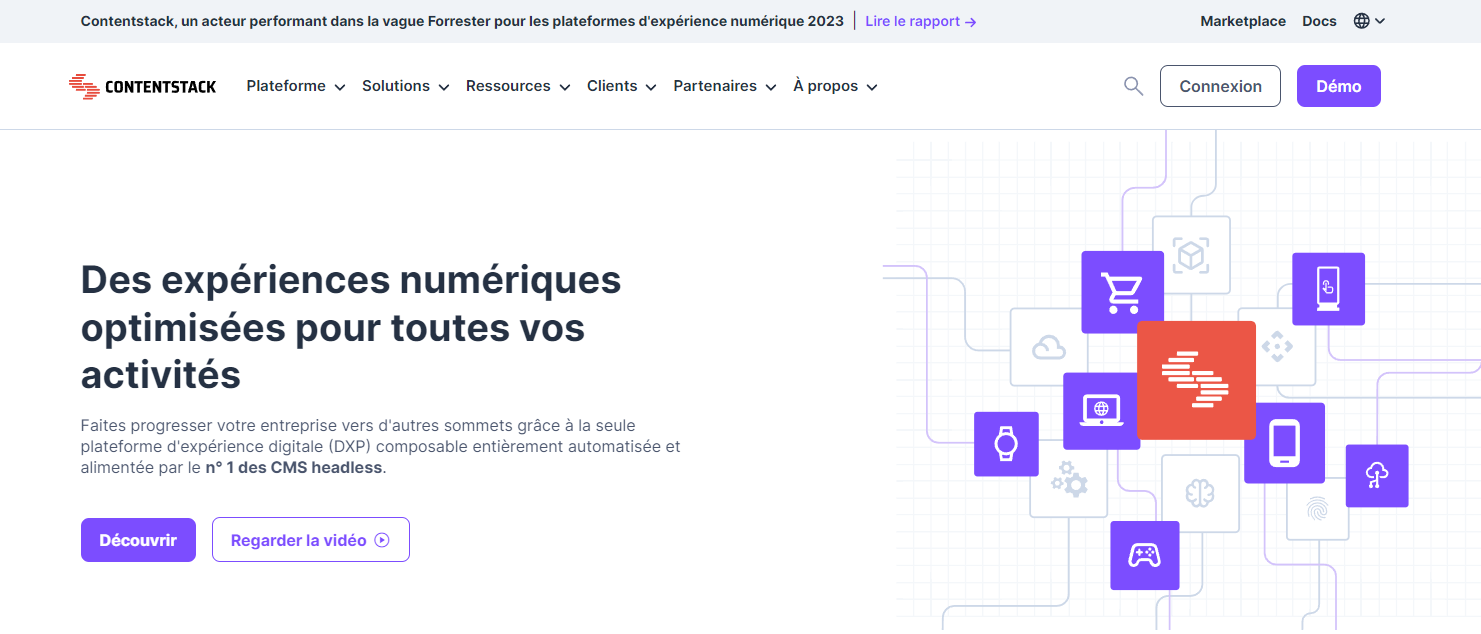
Contentstack utilizes REST APIs to render content across various devices and supports the integration of third-party applications, enhancing its flexibility and scalability. It is trusted by major companies like ASICS, Chase, and Shell for its ability to handle critical content experiences with dependability and scale. Known for its Care Without Compromise program, Contentstack boasts the industry’s highest customer satisfaction rating.
It is also a founding member of the MACH Alliance, advocating for microservices-based, API-first, cloud-native SaaS, and headless technology. For business users, Contentstack offers the ability to create personalized digital experiences rapidly, with an increase in publishing velocity by up to 90%. For developers, it provides a customizable tech stack with a built-in Marketplace, App SDK, and Developer Hub, increasing developer velocity by up to 80%.
This combination of high performance, customer-centric support, and advanced technology makes Contentstack a powerful choice for organizations looking to enhance their digital content management and delivery.
Directus
Reviews on G2: 5/5 (26 reviews)
Price for Entry-Level: Free; also offers paid options.
Directus stands out in the headless CMS market with a perfect score on G2 and is ranked as the 7th easiest to use in headless CMS software. It is an open data platform that works alongside any new or existing SQL database. Directus provides a robust toolkit for managing, visualizing, and connecting data, catering primarily to small businesses (77%) and enterprises (19%) in the computer software and program development industries.
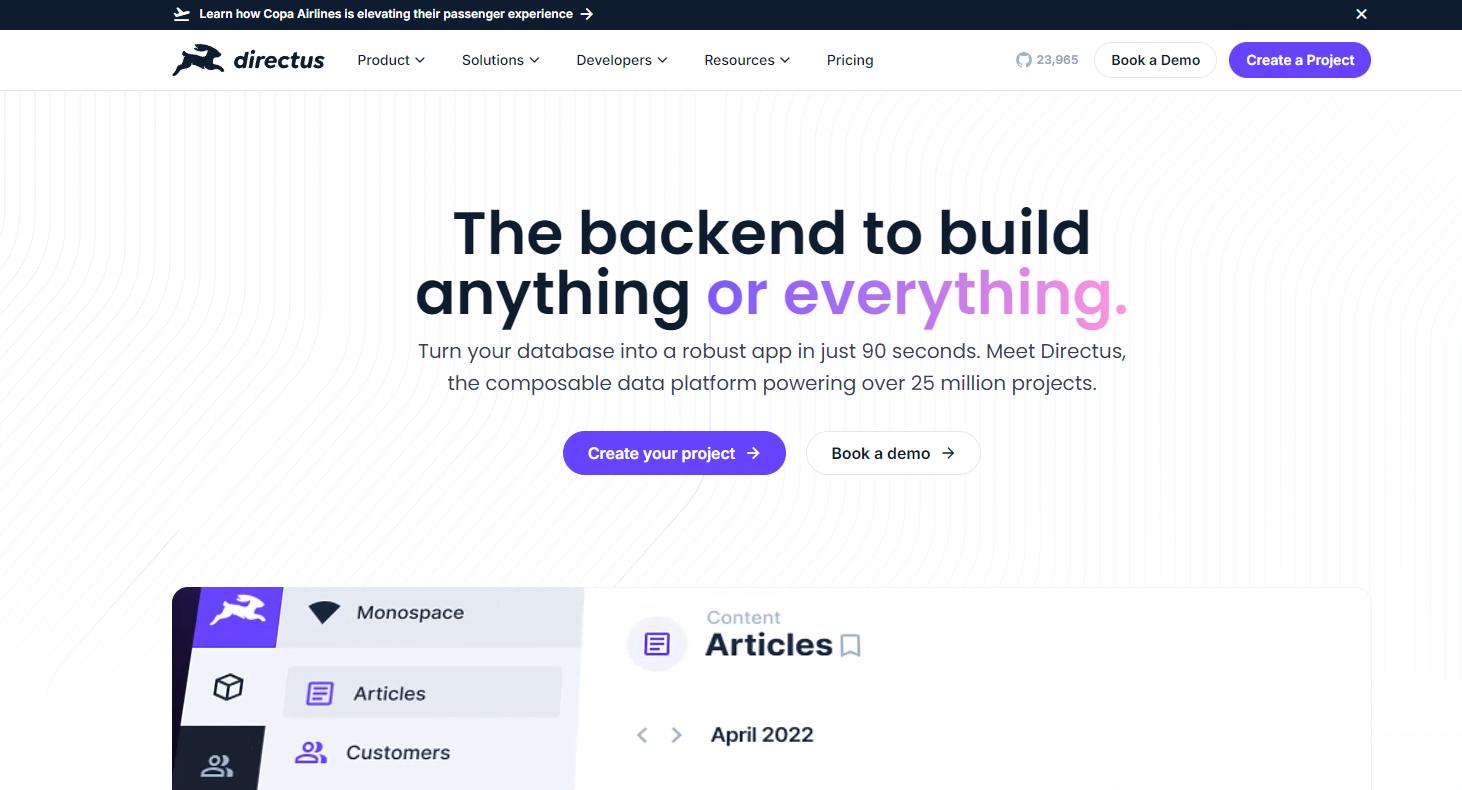
Directus is known for its flexibility and comprehensive feature set. It offers a self-documenting REST and GraphQL API, event hooks for logic, granular access control, and data workflows. The platform is fully customizable and open-source, built in TypeScript, and designed for extension, ensuring there is no ceiling to its features as your project grows.
Directus also stands out for its no-code application, allowing even non-technical business users to manage data efficiently. The front end includes flexible database content management, drag-and-drop dashboards, digital asset management, and internationalization support for global teams. Importantly, Directus operates without requiring any database migration or vendor lock-in, offering dynamic API and App functionality based on the project’s existing architecture.
With nearly two decades of development, over 21 million Docker downloads, and a large developer community, Directus is a proven solution for a wide range of use cases, from headless CMS to business intelligence and internal app building.
Kontent.ai
Reviews on G2: 4.3/5 (165 reviews)
Price for Entry-Level: Free plan available for community use; paid plans start at $2,999 a month.
Kontent.ai, a cloud-based headless CMS, is rated 4.3 out of 5 on G2 and is the 15th easiest to use in headless CMS software. Hosted on Microsoft Azure and utilizing Fastly for its CDN, Kontent.ai is designed to provide organizations with unparalleled returns on their content. It’s optimized for quick response and supports a wide array of APIs, including REST and GraphQL, making it adaptable to different technologies and frameworks.
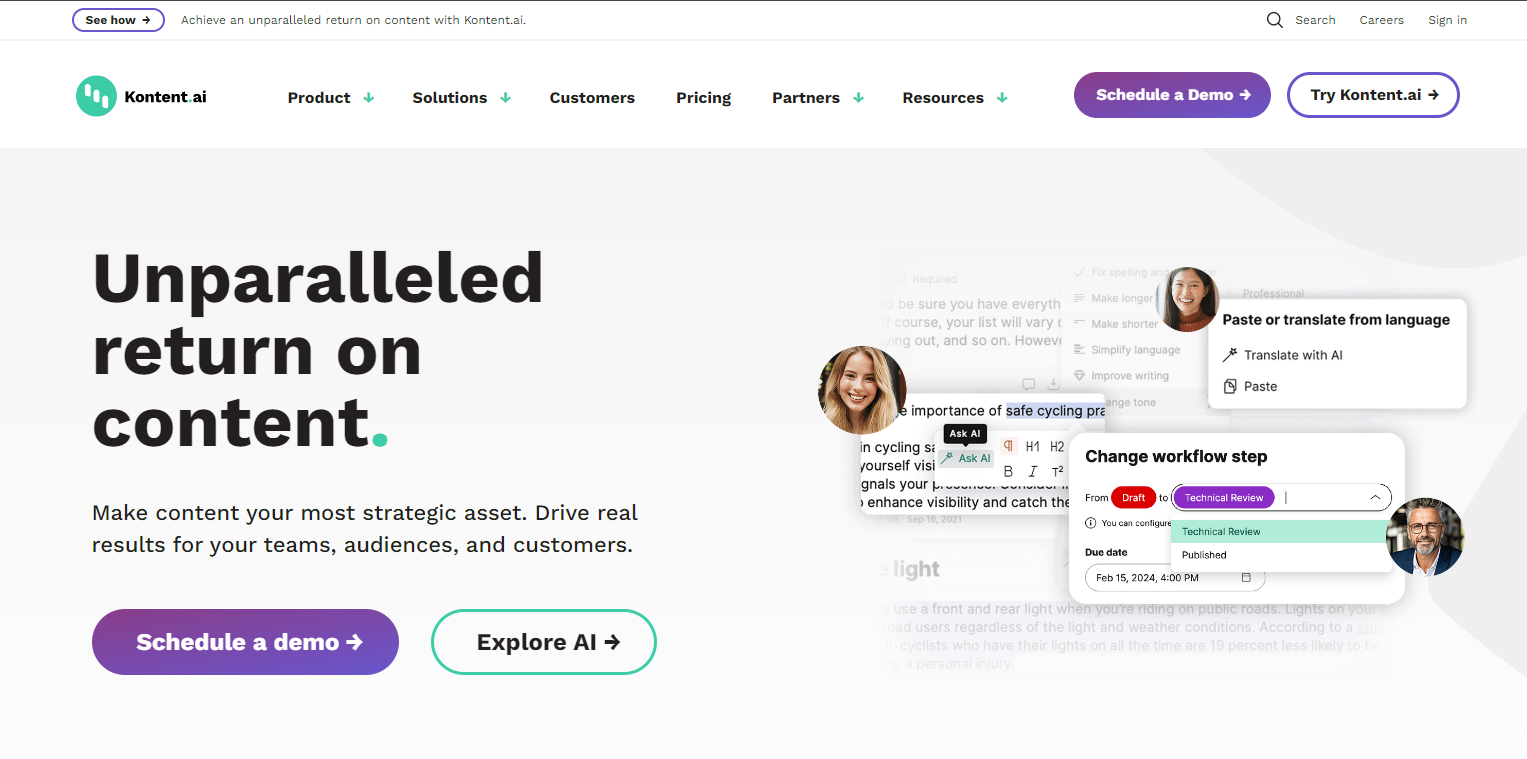
The platform stands out for its fast integration capabilities with frameworks and other applications. In Kontent.ai, control over content is central to all operations and workflows, aiding content creators, who are supported by native AI skills, to collaborate in real-time. This setup enhances idea generation, reduces bottlenecks, and maximizes the impact of created content.
For developers, Kontent.ai offers an incredibly adaptable API-first cloud-native solution, enabling the use of favorite technologies, languages, and frameworks to deliver seamless experiences. The platform serves a diverse market segment, with a significant focus on small businesses (41%) and mid-market companies (39%).
Kontent.ai’s approach to content management, emphasizing enterprise security, governance, and adaptability, makes it a comprehensive solution for businesses looking to future-proof their content strategies and create impactful digital experiences across various channels.
Best SEO Tools for Headless CMS SEO
seoClarity – The Best AI Assistant Tool for SEO
seoClarity stands out as a comprehensive all-in-one SEO tool, ideal for large enterprises and agencies. It offers a range of plans, starting with the custom-priced Essentials plan, and scaling up to the Professional plan at $4,500 per month, catering to various levels of SEO needs.
Its standout features include a generative AI assistant named Sia, powered by GPT technology, alongside an extensive suite of SEO analysis and content optimization tools. This makes it a versatile choice, capable of replacing multiple specialized SEO tools. However, its pricing, particularly for mid to high-tier plans, can be steep, and its interface, while functional, is relatively basic compared to the breadth of features it offers.
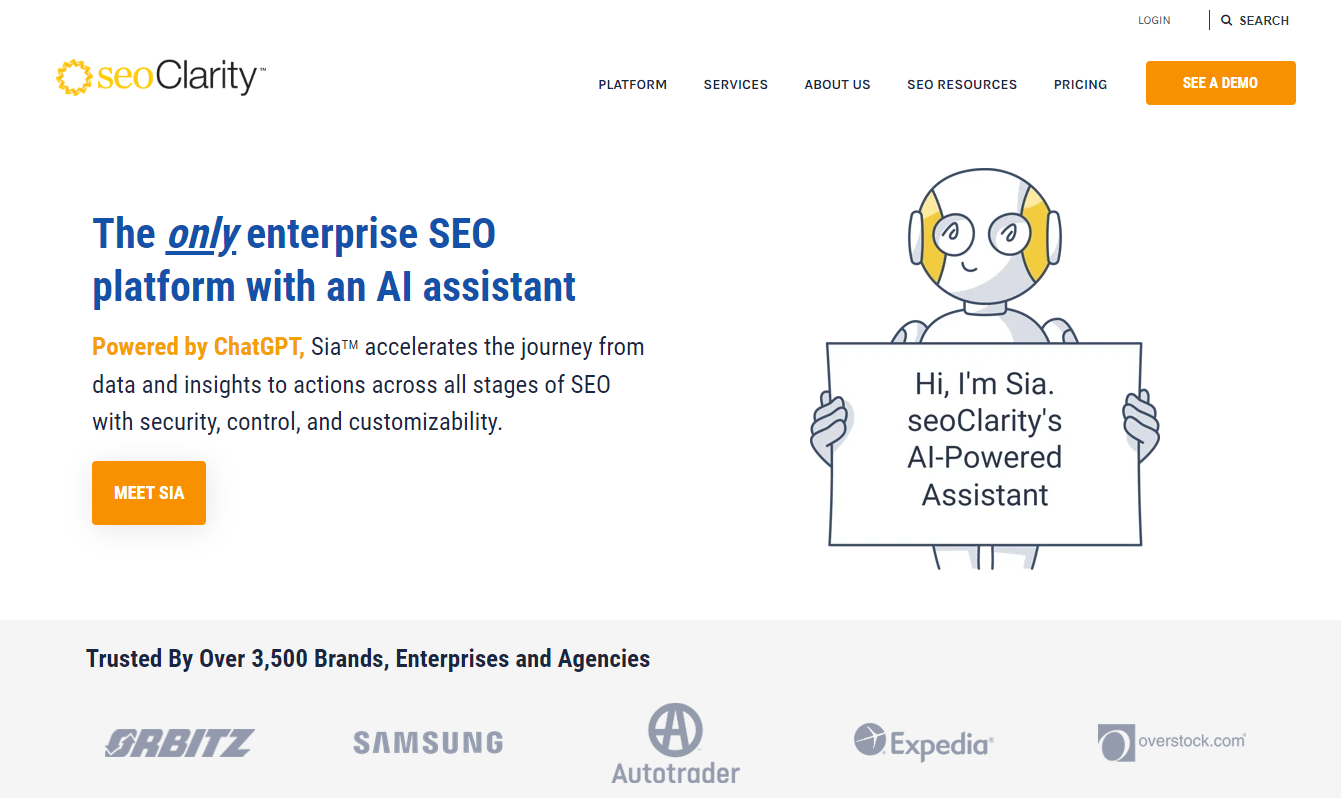
At its core, seoClarity provides robust SEO analysis capabilities, including rank monitoring, search trends insights, and competitor analysis, comparable to dedicated tools like Ahrefs or Semrush. Where it truly excels is in content creation and optimization, offering features like blog post generation from keywords and a Content Fusion tool for crafting content from scratch or existing URLs.
The AI assistant Sia enhances this experience by generating optimized content elements and aiding in bulk SEO tasks. While seoClarity’s comprehensive nature and advanced features justify its higher price point for large businesses and agencies, the platform might be less accessible for smaller enterprises due to its cost and somewhat bare-bones interface.
Surfer – The Best SEO Tool for AI Integration
Surfer emerges as a top choice for those seeking an SEO tool with integrated AI capabilities, particularly excelling in SEO auditing and offering insightful keyword research features. Its unique appeal lies in its AI integration, offering a suite of five tools: Keyword Research, Content Editor, Audit, Domain Planner, and SERP Analyzer. These tools, while similar to those found in other products, are enhanced by AI to provide more actionable insights.
For instance, Surfer’s AI-driven Content Editor allows users to easily create and optimize articles, with real-time feedback on structure, term usage, and content scoring. Additionally, the SERP Analyzer stands out with its detailed analysis of top-ranking pages, offering insights into various metrics like word and character counts, keyword density, and more.
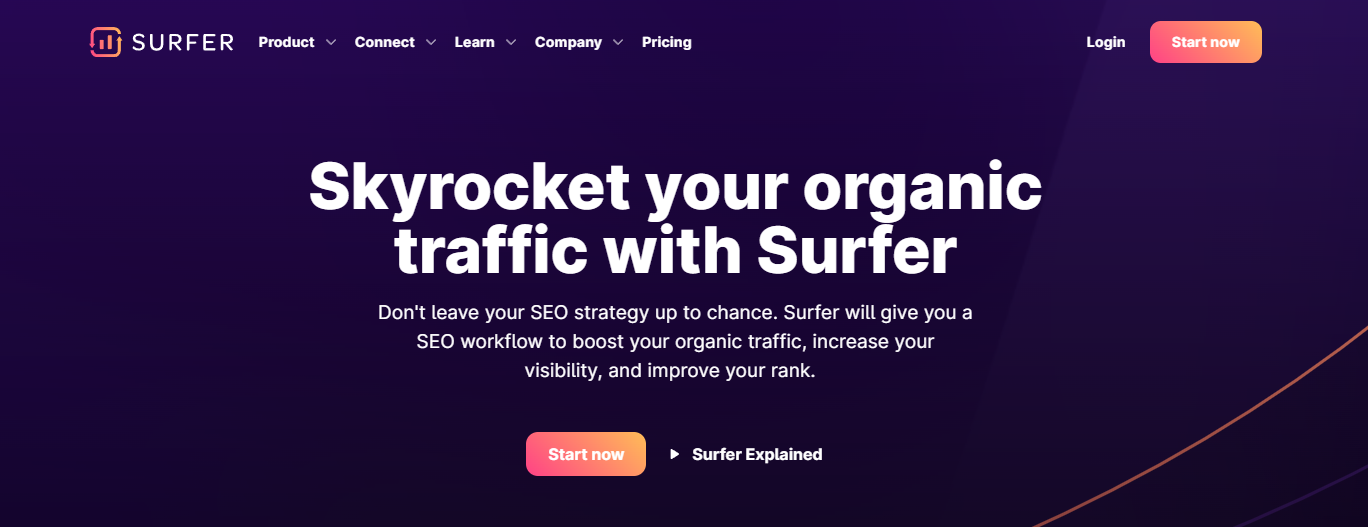
However, Surfer’s premium nature is reflected in its pricing and structure. The tool offers several plans, starting with the Essential plan at $89 per month and scaling up to the Enterprise level with custom pricing. A notable aspect of Surfer is its integration with Jasper, enhancing its content creation capabilities, though this comes with an additional cost of $29 per article for using Surfer AI.
Despite its higher cost and the requirement for credits that don’t roll over, Surfer’s combination of simple yet powerful AI integrations, unique SEO insights, and the ability to export content directly to WordPress makes it an attractive option for users looking for an advanced, AI-integrated SEO tool.
SEOptimer – The Best SEO Tool for SEO Audits
SEOptimer is a notable SEO audit tool, distinguished by its simplicity and effectiveness in diagnosing SEO-related performance issues for websites and individual web pages. It’s designed to quickly provide a comprehensive overview of a page’s SEO health, grading various aspects from A+ to F. This immediate feedback, coupled with a list of actionable recommendations, makes SEOptimer an insightful tool for identifying and addressing SEO shortcomings.
In addition to basic diagnostics, it offers a suite of tools for specific SEO elements, such as code minifiers, meta tag generators, and XML sitemap generators. However, the toolset for actually fixing issues is somewhat limited, and the tools provided are not as complex as those found in more advanced platforms.
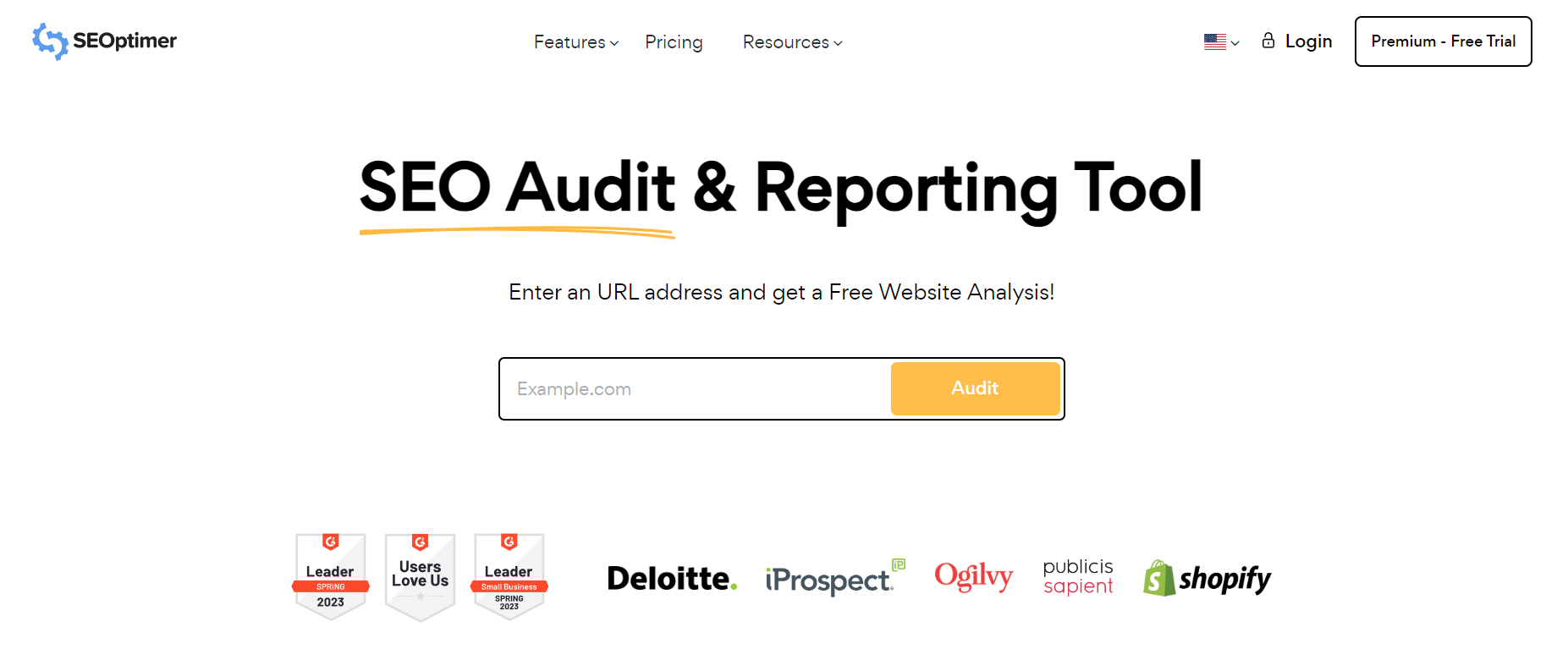
SEOptimer stands out for its accessibility and affordability, with plans starting at $19 per month, making it a reasonable choice for small businesses and digital agencies. While it doesn’t offer the depth of features found in more expensive tools, its fast and actionable diagnostics, combined with additional features like keyword ranking analysis and SERP presentation tools, make it a valuable product for users seeking straightforward, effective SEO audits.
SEOptimer’s pricing tiers cater to different needs, ranging from the DIY SEO plan for small business owners to the more comprehensive White Label and Embedding options for agencies. Despite some limitations in tool complexity, SEOptimer’s blend of simplicity, effectiveness, and affordability makes it an appealing choice for those needing quick and straightforward SEO audits.
Semrush – The Most Comprehensive SEM Tool Available in the Market
Semrush stands out as a premier SEO tool, earning the trust of over 10 million marketing professionals and garnering 21 international awards for being the best SEO software suite. Its widespread adoption by 30% of Fortune 500 companies further cements its reputation as a go-to marketing tool.
This extensive user base and recognition highlight Semrush’s effectiveness and reliability in the field of digital marketing and SEO optimization. The platform’s success is underpinned by its capacity to provide comprehensive and insightful data, a critical factor in navigating the competitive landscape of online marketing.

The platform’s impressive capabilities are reflected in its vast database, which includes 25 billion keywords, 43 trillion backlinks, and 808 million domain profiles across 140 geo databases. This wealth of data equips users with unparalleled insights, giving them a significant edge in SEO strategy and execution.
For headless CMS users, Semrush’s extensive backlink crawler and keyword databases are invaluable for optimizing content across various channels and platforms. The platform’s ability to deliver detailed and actionable insights makes it an essential tool for any headless CMS SEO strategy, helping users stay ahead of the competition with data-driven decisions.
Ahrefs – The Best SEO Tool for Competitor Research
Ahrefs stands out as a key player in the SEO tools market, particularly for its strengths in competitor research and rank tracking. Offering slightly more affordable options than its competitor Semrush, Ahrefs appeals to users seeking a premium tool for analyzing and monitoring search engine rankings.
Its pricing tiers are designed to accommodate a range of users, starting with the Lite plan at $99 per month, progressing to the Standard plan at $199, the Advanced plan at $399, and culminating in the Enterprise plan at $999 per month. This structure makes Ahrefs accessible to small businesses, freelance SEO professionals, in-house marketing teams, and large enterprises.
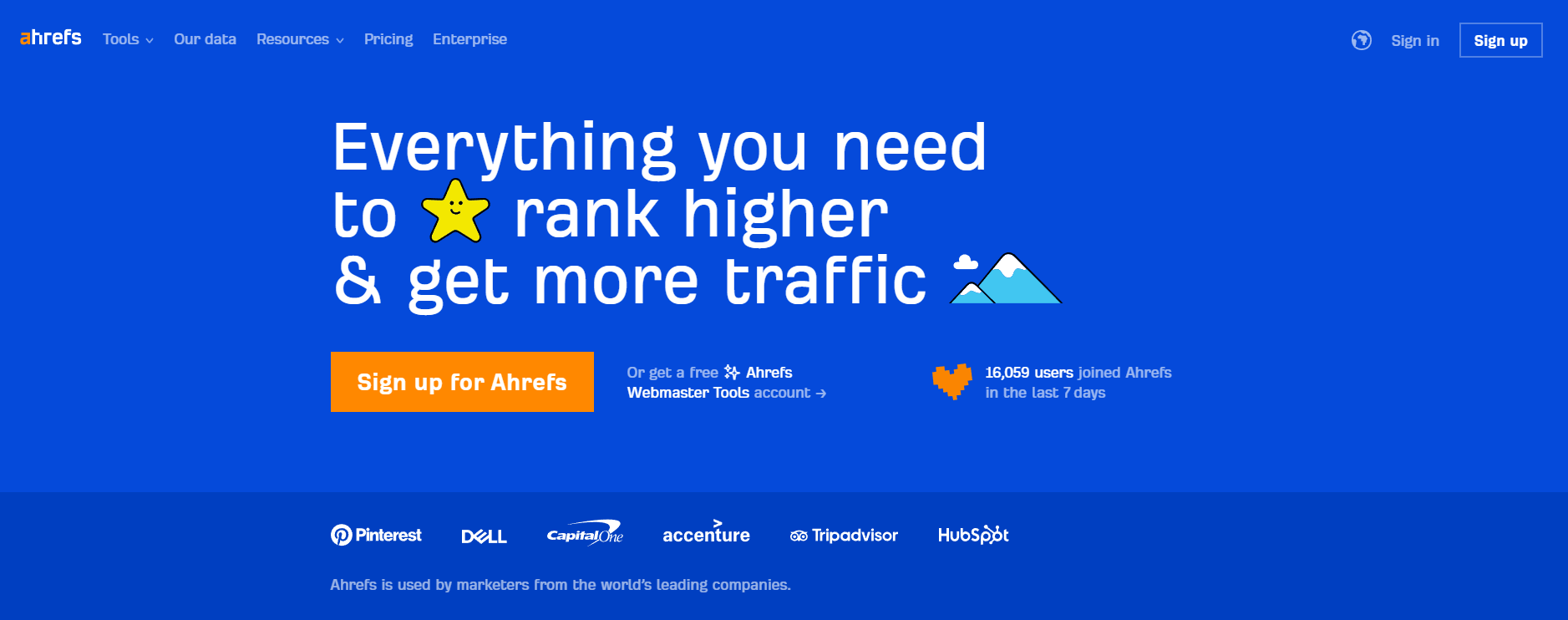
Key features of Ahrefs include accurate and timely ranking data, detailed keyword analytics, and a suite of competitor analysis tools. The Content Gap and Link Intersect tools provide in-depth insights into competitors’ keyword strategies and backlink profiles, offering valuable data for crafting competitive SEO strategies.
Additionally, Ahrefs’ ability to analyze the traffic value of keywords offers a unique perspective on the potential financial benefits of SEO efforts. While its suite is mostly focused on analysis and monitoring, with limited reporting tools, Ahrefs’ comprehensive approach to rank tracking and competitor research solidifies its position as a top choice for users prioritizing these aspects in their SEO endeavors.
Tips for a Better SEO on Headless CMS
Structuring Content for SEO
Structuring content for SEO is essential for enhancing search engine visibility and user experience. Given that a headless CMS separates content management from content delivery, it’s crucial to ensure that content is discoverable and understandable by search engines for better ranking. This approach also improves user engagement across various platforms, from websites to mobile apps.

Here are a few tips you can do to effectively structure content for SEO in a headless CMS environment:
- Organizing Content Taxonomy: In a headless CMS, it’s essential to structure content with a clear and logical hierarchy. This involves organizing content into well-defined categories and tags, which not only aids in search engine indexing but also enhances user navigation. Ensuring that your URLs are descriptive and include relevant keywords is equally important for better indexing and user understanding.
- Using Metadata for SEO: Metadata plays a crucial role in SEO. Optimizing title tags with relevant keywords can significantly impact search rankings and user engagement. Similarly, crafting concise meta descriptions that incorporate target keywords can improve click-through rates, despite not being a direct ranking factor. Additionally, using descriptive alt tags for images, and incorporating relevant keywords boosts both searchability and accessibility.
- Leveraging Schema Markup: Implementing schema markup is crucial for helping search engines understand the context and content of your website. Structured data markups enable your site to qualify for rich results in search engine results pages (SERPs), potentially increasing visibility and user engagement. Regular testing and validation of schema markup using tools like Google’s Structured Data Testing Tool ensure correct implementation and maximization of SEO benefits.
- Structured Data for Rich Snippets: To enhance visibility in SERPs, it’s important to target the types of rich snippets most relevant to your content. For instance, e-commerce sites should include detailed product information in structured data for rich snippets. Regular monitoring of the performance of these snippets helps in refining SEO strategies for better results.
Optimizing for Speed and Mobile
Fast page load times are critical in today’s digital landscape. They not only influence user experience but also affect SEO rankings. Search engines like Google prioritize websites that load quickly, as slow-loading sites tend to have higher bounce rates. This is especially important for mobile users who often access content on the go and expect rapid loading. Optimizing load times can lead to better engagement, lower bounce rates, and improved search rankings.
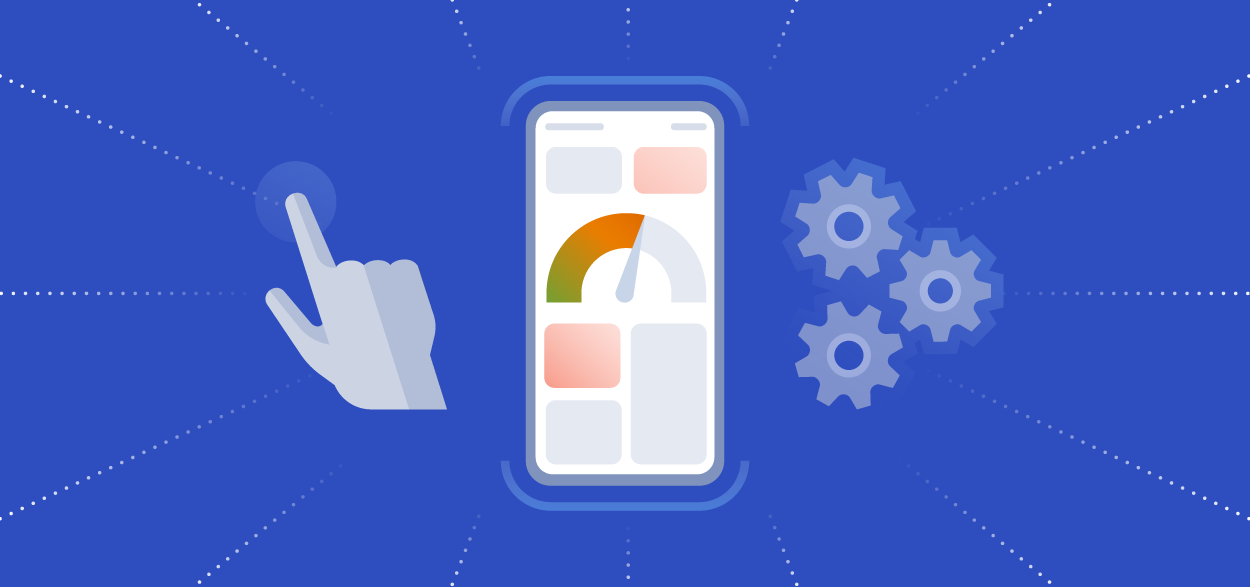
Here are a few things that might help you to optimize your website:
- Responsive Design and Mobile-First Approach: A responsive web design ensures that your website adapts to various screen sizes and devices, providing an optimal experience for all users. With the increasing use of mobile devices for internet browsing, adopting a mobile-first approach is essential. This means designing your website primarily for mobile users, ensuring that it’s navigable, readable, and accessible on smaller screens, which, in turn, positively impacts SEO and user engagement.
- Implementing Accelerated Mobile Pages (AMP): AMP is an open-source framework designed to make mobile pages load faster. By implementing AMP, you can create lightweight pages that load quickly on mobile devices. This is particularly beneficial for content-heavy websites. AMP versions of web pages are favored by Google, often loading near-instantaneously, which can significantly improve the user experience and contribute to better SEO performance.
- Image and Video Optimization: Images and videos are essential components of modern web design but can significantly slow down page load times if not optimized properly. For images, using formats like WebP, which provides high-quality results at smaller file sizes, is beneficial. Videos should be compressed and embedded in a way that does not impede page loading. Employing lazy loading, where images and videos only load when they enter the viewport, can also greatly enhance page speed.
Advanced SEO Practices with Headless CMS
Although there are so many more ways to improve your search rank, we want to provide you with a few effective advanced SEO practices with a headless CMS. These practices, when executed effectively, can greatly enhance the online visibility and search engine ranking of your website, leveraging the flexibility and power of a headless CMS system.
- Creating SEO-Friendly URLs: Creating SEO-friendly URLs is a cornerstone of advanced SEO practice in a headless CMS environment. These URLs should be concise, easy to read, and include relevant keywords that accurately describe the content of the page. A well-structured URL not only helps users understand the content at a glance but also enables search engines to crawl and index the site more effectively. It’s important to maintain a consistent URL structure across the website, ensuring they are logical and intuitive.
- Internal and External Linking Strategies: Effective internal and external linking strategies are vital for SEO. Internal linking involves linking to other pages within your website, which helps in distributing page authority and guiding users and search engines to more relevant content. External linking, on the other hand, refers to linking to authoritative external sources. This practice lends credibility to your content and can improve your site’s authority. A balanced approach to both internal and external linking is crucial for enhancing the SEO performance of your headless CMS-based website.
- Consistent Content Updates and Quality: Regularly updating your website with high-quality content is essential for maintaining and improving SEO rankings. Search engines favor websites that provide fresh, relevant, and high-quality content. This means regularly reviewing and updating existing content while also adding new, valuable content. Quality content is informative, engaging, and tailored to meet the needs and interests of your target audience. Consistent content updates signal to search engines that your site is active and relevant, contributing to higher rankings.
- Addressing Duplicate Content Issues: Duplicate content can significantly hinder SEO efforts. It confuses search engines, as they struggle to determine which version of the content to index or rank. This can lead to a split in page authority and negatively impact your website’s SEO performance. In a headless CMS, it’s important to proactively identify and resolve duplicate content issues. This can be done through canonical tags, which tell search engines which version of the content is the original, or by modifying or removing duplicate content.
Measuring SEO Performance for Headless CMS
In a headless CMS, where content management and delivery are decoupled, routine measuring provides a comprehensive understanding of how SEO efforts translate into tangible results. This holistic approach to measuring SEO in a headless CMS environment not only helps in fine-tuning your SEO strategies for better performance but also aligns them more closely with your overall business and marketing goals.
Here are steps you can take to effectively measure and optimize your SEO performance in a headless CMS environment.
Setting SEO KPIs
To effectively measure SEO performance in a headless CMS, it’s crucial to first establish Key Performance Indicators (KPIs). These should be aligned with your overall business and marketing goals. Common SEO KPIs include organic traffic, search engine rankings for targeted keywords, click-through rates (CTR), and more. There are many more SEO KPIs for eCommerce you can find out.

Setting clear, measurable KPIs allows you to track progress, identify areas for improvement, and make data-driven decisions. Tracking these metrics allows for a clear assessment of how well your content performs in search results, providing data-driven insights for optimization. Additionally, analyzing user engagement and conversion metrics offers a comprehensive view of how users interact with your content and the effectiveness of your website in meeting its conversion goals.
Using Google Analytics and Search Console
Google Analytics and Google Search Console are indispensable tools for measuring SEO performance. Google Analytics provides insights into website traffic, user behavior, and engagement metrics. It helps in understanding how users interact with your site, the source of your traffic, and what content resonates with your audience. Google Search Console, on the other hand, offers valuable data regarding search queries, site visibility in search results, and technical status like crawl errors and indexing issues. Together, these tools offer a comprehensive view of your website’s SEO performance.
- Tracking Keyword Rankings: Monitoring keyword rankings is vital for understanding the effectiveness of your SEO strategies. Tracking how your keywords perform in search engine results pages (SERPs) helps in assessing the visibility of your content and understanding the competitiveness of your keywords. This also involves monitoring both short-tail and long-tail keywords relevant to your business and analyzing trends or shifts in rankings over time.
- User Engagement and Conversion Metrics: Beyond traditional SEO metrics, assessing user engagement and conversion rates is key to measuring the real impact of your SEO efforts. Engagement metrics such as time on site, pages per session, and bounce rate provide insights into how users interact with your content. Conversion metrics, on the other hand, help in understanding how effectively your website meets its business objectives, such as generating leads, sales, or subscriptions. These metrics are crucial in evaluating the ROI of your SEO strategies.
SEO and Content Marketing for headless CMS
In a headless CMS, the synergy between content and SEO is pivotal. The CMS’s flexible content delivery allows for optimized content distribution across various channels, enhancing SEO efforts. Quality content, enriched with targeted keywords and structured for search engines, drives organic traffic and improves search rankings. SEO strategies, in turn, inform content creation, ensuring it meets the needs of the target audience and search engine criteria. This symbiotic relationship is key to driving visibility and engagement in a headless CMS setup.
Effective promotion and distribution of content through channels like email marketing, online forums, and collaborations with influencers expand audience reach and amplify content impact, complementing SEO efforts. Regularly creating and publishing keyword-optimized blog posts not only attracts and retains audience attention but also bolsters SEO. Guest posting on reputable websites extends content reach further, driving traffic and improving domain authority. Additionally, an active social media presence increases content visibility, drives traffic, and provides valuable insights into audience preferences. These combined tactics in a headless CMS framework effectively build brand authority, enhance SEO, and ensure a broader and more engaging online presence.
Case Studies of Successful Headless CMS SEO
Made.com
The Made.com case study showcases a triumphant application of SEO strategies in an eCommerce setting, particularly leveraging the advantages of a headless CMS. Their strategy focused on onsite improvements, site architecture optimization, and natural PR activities to enhance SEO performance.
Significant efforts were made in restructuring the site’s navigation and categorization based on SEO data, renaming products for better SEO alignment, and using SEO insights to inform product purchasing decisions. A key milestone was the migration to a React and headless CMS platform, which was driven by SEO initiatives, thus overcoming the limitations of the previous Magento system.

This strategic overhaul led to remarkable results over three years, including a £10.4 million increase in non-brand SEO revenue and the acquisition of nearly one million new users. Made.com achieved number-one rankings in key product categories, signifying the success of its integrated SEO approach in a headless CMS environment. This case study exemplifies how a focused SEO strategy, coupled with the flexibility of a headless CMS, can significantly boost online presence and revenue in the competitive eCommerce landscape.
Tipico
The Tipico Marketing case study exemplifies the successful implementation of a headless CMS for enhanced SEO and marketing efficiency in the highly regulated US sports betting and online casino market. Facing challenges like the absence of a dedicated marketing tool, a complex existing infrastructure, the need for code reusability, and a custom tracking system, Tipico turned to Focus Reactive to develop a solution using Sanity CMS.
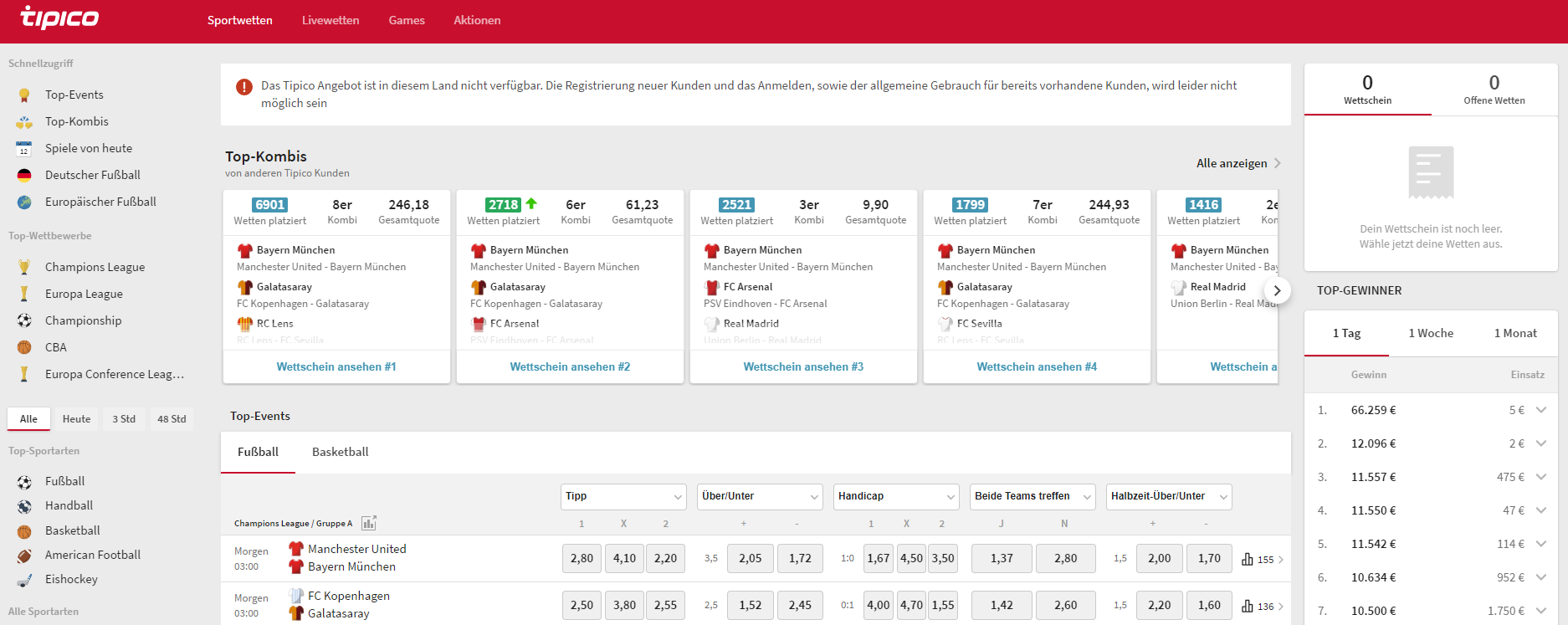
This technical overhaul led to significant achievements: a themeable site manageable at the CMS level, 100% uptime even during peak traffic, seamless integration with other client products, a drastic reduction in build time to just 2 minutes, and industry-leading page speeds. Additionally, technical SEO enhancements were made for optimal visibility, and numerous custom integrations with external services automated content generation.
The project effectively managed a massive flow of data and requests, ensuring a smooth and responsive user experience, particularly on mobile devices. This case study demonstrates how a strategically implemented headless CMS can significantly enhance marketing and SEO capabilities in a complex and regulated industry.
Conclusion
The integration of headless CMS with SEO strategies marks a turning point in digital content management and online visibility. By exploring various headless CMS platforms and SEO tools, we’ve highlighted the significant advantages they offer, such as improved site performance and user engagement. Successful case studies like Made.com and Tipico demonstrate the real-world benefits of headless CMS adoption.
As digital demands continue to grow, understanding and leveraging headless CMS in SEO becomes crucial for staying competitive and achieving long-term online success. Don’t forget to subscribe to our newsletter to receive the latest insights from the market.











